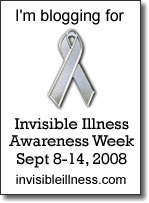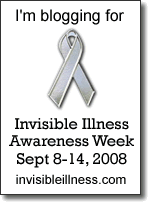 RSS FEED
RSS FEED
Archive for the ‘Advocacy’ Category
Pills, Nasal Sprays, Injections, and Now a Patch?
February 27th, 2009
 A clinical trial was begun this past fall, of sumatriptan delivered by transdermal patch. Sumatriptan, the first to be developed of the triptan drugs, is a Migraine abortive, which acts directly on the trigeminal nerve to abort a Migraine attack in progress. It was available only as the brand-name, Imitrex, until the past couple of months when the pills and the injectable form came off patent and were approved as generics. Triptans can be taken by about three quarters of Migraineurs and are effective in aborting a Migraine, if taken early enough, roughly three-quarters of the time.
A clinical trial was begun this past fall, of sumatriptan delivered by transdermal patch. Sumatriptan, the first to be developed of the triptan drugs, is a Migraine abortive, which acts directly on the trigeminal nerve to abort a Migraine attack in progress. It was available only as the brand-name, Imitrex, until the past couple of months when the pills and the injectable form came off patent and were approved as generics. Triptans can be taken by about three quarters of Migraineurs and are effective in aborting a Migraine, if taken early enough, roughly three-quarters of the time.
Regarding the patch, I think it’s a good idea. The injections work better than the pills for most people, me included. Bypassing the digestive system seems to limit side-effects, especially nausea, and personally I’d love to have the faster absorption like the injections without the major ouch of giving myself a shot! That said, I imagine the manufacturer is happy to have something they can patent and charge top dollar for, now that the pills and injections are out in generic. Call me cynical… but only partly!
I have to applaud every advance in Migraine treatment, small though it may be. And though you may call me a broken record, I am still your fired up advocate here and want to point out that we have had no new medications developed for Migraine, other than the triptans, in the past 15 years. So a little yay for another way to deliver triptans.
A way bigger yahoo! would be for more effective abortives, that could be taken by people with heart conditions, AND for effective preventives without hideous side effects that are actually developed for Migraine disease, not hand-me-downs from other diseases. Call me crazy? Well, a girl can dream!
– Megan
Patchwork quilt image courtesy of LePetitPoulailler.
Tags: imitrex, Migraine abortive medication, Migraine medication, Migraine preventive medication, sumatriptan, transdermal patch
Posted in Advocacy, Medicine | Comments (0)
Headache on the Hill
February 25th, 2009
 I spent the day yesterday doing something I’ve never done before – lobbying Congress. I’m not entirely sure I would ever have predicted that I would lobby Congress. It was a great experience, and one that I’m sure will take me several posts to process and tell you about. But I can at least get started. The Alliance for Headache Disorders Advocacy (ADHA) is a wonderful group of doctors, advocates, writers and researchers who are fighting for better headache care for YOU. I arrived in DC on Monday for a training session put on by the AHDA and learned some key things about the underfunding of Migraine and headache disorders research, and about how to lobby.
I spent the day yesterday doing something I’ve never done before – lobbying Congress. I’m not entirely sure I would ever have predicted that I would lobby Congress. It was a great experience, and one that I’m sure will take me several posts to process and tell you about. But I can at least get started. The Alliance for Headache Disorders Advocacy (ADHA) is a wonderful group of doctors, advocates, writers and researchers who are fighting for better headache care for YOU. I arrived in DC on Monday for a training session put on by the AHDA and learned some key things about the underfunding of Migraine and headache disorders research, and about how to lobby.
Nearly 40 of us spent Tuesday on Capitol Hill speaking to legislators and legislative aides. I visited two senators and three congressmen from my state, along with another Migraine sufferer. We were requesting that they add language to the 2010 appropriations bill which will direct the National Institutes of Health (NIH) to spend a larger share of their funds on Migraine and Headache Disorder research.
Here are some of the things I learned, straight from the AHDA fact sheet which we shared with the legislative aides:
Headache Disorders are the most prevalent neurological disorders. This year:
- More than 25% of middle aged American women will have a Migraine attack.
- 25% of American families will have a member with a Migraine attack.
- 19% of all Iraq war veterans will have a Migraine attack.
- 12% of all Americans will have a Migraine attack.
- 4% of all Americans will have chronic daily headache.
US costs for headache disorders this year will be:
- greater than $31 billion in total economic losses.
- 9% of all lost labor productivity.
- greater than the costs due to epilepsy, asthma and ovarian cancer combined.
Migraine is extremely disabling, resulting in:
- attacks that can be as disabling as quadriplegia or active psychosis.
- more lost years of healthy life in the US than due to epilepsy, multiple sclerosis, and ovarian cancer combined.
- an increased risk of cardiovascular disease leading to at least 1500 additional deaths in the US annually.
What has the response of the NIH been so far? The NIH is responsible for funding, with our taxpayer dollars, the basic research that makes medical innovation possible. So far the NIH funding for research on headache disorders is less than $13 million annually which comes to less than 0.05% of the NIH budget. Research of NIH funding relative to disease burdens (the impact of a disease on society, including prevalence, economics, disability, and mortality, as discussed above), shows that a fair share of funds for headache disorders (compared to other diseases with similar disease burdens) should be at least $103 million annually.
We got a good reception, particularly from our senators’ aides. There is more work to do, but I think we are making an impact. You can make an impact too. Go to the ADHA site and sign up for their action alerts. On Monday, March 2 we will be asking you to email your congressional representatives, asking them to sign on to the language directing the NIH to do the right thing with regard to headache disorders. If you sign up for AHDA action alerts today, taking action next week will be as easy as a couple of clicks.
– Megan
We can make a difference!
US Capitol image courtesy of Kim Baker.
Tags: AHDA, Alliance for Headache Disorders Advocacy, Chronic Daily Headache, disability, disease burden, headache disorders, migraine
Posted in Advocacy, Current Affairs, Medicine, Science, Uncategorized | Comments (9)
There is NO link between Vaccinations and Autism
February 10th, 2009
Doctor who Published False Study Data Exposed as a Fraud:
Please read this Times of London investigative report on the falsification of data by Dr. Andrew Wakefield.
MMR doctor Andrew Wakefield fixed Data on Autism
Wakefield’s fraudulent article in The Lancet in 1998 gave rise to a significant decline in vaccination. (From 92% in the mid-90’s to 80% today), and to steadily rising cases of measles, including several measles deaths. Measles cases in Great Britain increased 24-fold in that same time period.
Wakefield claimed a connection between MMR vaccine and autism, based on a study of only 12 patients, and The Times recently discovered from hospital records that for the majority of the patients, their symptoms predated the vaccinations. Wakefield falsely reported in the study that the symptoms occurred after the vaccinations.
It boggles my mind that someone would falsify this kind of information. This mis-information, once published, is extremely hard to eradicate from the public consciousness. My heart goes out to every parent struggling with an autistic child, but the public health implications here are staggering. Most of us are too young to remember the rampant epidemics of every period of human life up to the late 20th century. This kind of irresponsible rumor-starting could lead to our next rampant epidemic. Indeed, in third world countries, children die of measles all the time. Measles can kill, blind and deafen.
Vaccinate your children! It is a serious public health issue!
– Megan
Tags: autism, Dr. Andrew Wakefield, measles, MMR, public health, Times of London
Posted in Advocacy, Medicine | Comments (8)
Help Us Get Better Treatment
February 7th, 2009
 Most of the time we do what we can to manage our own Migraines and support others, but don’t feel like we can have much of an impact on the disease itself or our treatment options. Coming up on February 24th is the Alliance for Headache Disorders Advocacy‘s (ADHA) Annual “Headache on the Hill” – a day of advocacy on Capitol Hill where we will be lobbying our Congressional representatives for a larger share of National Institutes of Health dollars for Migraine and Headache Disorders research. I’m very excited to tell you that I will be in Washington along with Teri Robert and a number of leading Migraine specialists and advocates to speak with my Congressman and Senators. Read some more about what Teri has to say about it here: We Need Your Help to Get Better Migraine Treatment.
Most of the time we do what we can to manage our own Migraines and support others, but don’t feel like we can have much of an impact on the disease itself or our treatment options. Coming up on February 24th is the Alliance for Headache Disorders Advocacy‘s (ADHA) Annual “Headache on the Hill” – a day of advocacy on Capitol Hill where we will be lobbying our Congressional representatives for a larger share of National Institutes of Health dollars for Migraine and Headache Disorders research. I’m very excited to tell you that I will be in Washington along with Teri Robert and a number of leading Migraine specialists and advocates to speak with my Congressman and Senators. Read some more about what Teri has to say about it here: We Need Your Help to Get Better Migraine Treatment.
So, here’s what happens in the meantime. The ADHA will need your help in writing to your representatives sometime soon, possibly before Headache on the Hill, to inform them about the issues and ask them to lend their support. Could you please go over to the ADHA site today and sign up for their mailing list? This way you will know when it’s time to write your representatives. Why are Migraine and Headache Diseases so under-represented when it comes to our National Health dollars? Probably because we haven’t had the kind of organized advocacy that other diseases have had, but we can change that now!
I’ll let you know here when it’s time to write to your representatives, but please sign up with ADHA today so that you don’t have to rely on me! Thanks for your help!
– Megan
Tags: action alerts, Alliance for Headache Disorders Advocacy, Headache on the Hill, migraine advocacy, Migraine disease, Teri Robert
Posted in Advocacy, Medicine | Comments (0)
Radio Piece on Migraines, Neurological Illness, and More
November 20th, 2008
On Tuesday I had the great good fun to be interviewed by Coach Marla Martindale of  A Winning Life with RSD, along with her co-host Chris Tatevosian, author of Life Interrupted – It’s Not All About Me. Marla’s weekly radio show Winning Life Through Pain is on every Tuesday and deals with living well with chronic illness, and other health related topics. We talked about managing life with Migraine, Migraine myths and tips for coping, communicating about our illness, and how to calm down our nervous systems, as well as discovering a lot of similarities in dealing with other neurological illnesses like RSD and MS. Oh and there were a few references to baked bees and general silliness. You can discover that for yourself, if you like. Give a listen.
A Winning Life with RSD, along with her co-host Chris Tatevosian, author of Life Interrupted – It’s Not All About Me. Marla’s weekly radio show Winning Life Through Pain is on every Tuesday and deals with living well with chronic illness, and other health related topics. We talked about managing life with Migraine, Migraine myths and tips for coping, communicating about our illness, and how to calm down our nervous systems, as well as discovering a lot of similarities in dealing with other neurological illnesses like RSD and MS. Oh and there were a few references to baked bees and general silliness. You can discover that for yourself, if you like. Give a listen.
(Oh, a warning, it’s a big file – 27.4 MB, so you if you’d rather not deal with loading it, go to Winning Life Through Pain to listen.)
– Megan
Tags: chronic illness, migraine, neurological illness, radio, Weblogs
Posted in Advocacy, Communicating, Tips & Techniques, Weblogs | Comments (0)
Health Insurance Headaches
October 8th, 2008

Warning – Full blown rant ahead. I am so upset I can hardly stand it. I think my head may explode. I know I have criticized the media for using Migraine loosely to describe a hassle, but I’m using it literally here. My health insurance company, which is supposed to guard and foster my health, is about to give me a bona fide Migraine! Adrenaline triggered, high blood pressure triggered, crying triggered, you name it. And then they won’t want to pay for my medication.
I just received a notice that as of November 1, my health insurance premiums will go up by over 60%. I receive group insurance through a professional association, and so I am one of those self-employed small business owners who is paying for my own premiums. These are the group rates, mind you, if I tried to get my own insurance outside the group the premiums would be even higher. Our health care is already the one of the largest costs in our budget, after shelter. Higher than utilities, auto fuel, higher than food. The monthly premium for our family of four will go up about $800, to over $2000. And that’s just the beginning. We already have:
- a $30 co-pay for doctor visits;
- a $50 specialist co-pay (“specialist” includes physical therapy for headache prevention – $50 out of pocket every time I go – my neurologist wants me going twice a week, I manage twice a month at those rates);
- most of the medications our family uses are considered “Tier 3” and have a $50 co-pay as well, so that’s a good $400 at the pharmacy every month;
- we have a $2000 deductible for out of network doctors (and we do use some of the same doctors who we like and trust and have used for years – silly us – so picky, huh?);
- after we’ve forked out that $2000 deductible, we have a 30% co-pay for out-of-network; and
- all claims must be submitted in 90 days or they are rejected.
That last is a doozy – take someone who is chronically ill and has trouble keeping up with paperwork, and you have a perfect formula to never have to pay on some large proportion of their claims. Every previous insurance company I’ve had gave you 6 months to a year to submit claims.
Oh, and I almost forgot. This company routinely loses about 1/3 of everything I send them. So I have to keep to a very strict schedule to get everything in, then I send the claims, get nothing back, call them, they have no record, and they tell me, “Oh, if our scanner can’t read it, it’s destroyed.” Destroyed. I pay these people over $15,000 a year, soon to be over $24,000 and they destroy my paperwork? Then I have to dig out my copies, send another set with a cover letter, and guess what, they send half of those back saying they weren’t submitted within 90 days.
To all the costs above, let’s add that I spend a good 2 days of my time every other month dealing with my health insurance claims, mostly with their screw-ups, uncompensated, of course, taking time away from earning my living.
I’m naming names here. It’s Oxford Health Insurance, a United Healthcare Company. They grant me the privilege of paying them an additional 60% for this abuse starting next month. The reason? Our group has a higher than average rate of claim submission! Aha! So, let’s analyze this – first of all, this is a group of coaches, whose job is to get people organized and on track to achieve their goals – maybe we have a higher than average ability to actually find our way through the impossible obstacle course that Oxford has set up to keep people from submitting claims!
But then, remind me, what’s the insurance for? Call me naive, I thought it was there so I could afford health care! I didn’t realize it was for the profit of the insurance company, first, foremost, and exclusively! I’ve got no problem with business, I’m in business myself, but I do have a problem with the profit motive here, where it’s destroying the very purpose of the product! Dare I suggest a single-payer system? This is not auto insurance. You raise rates on bad drivers, to give people an incentive to be good drivers. So you raise rates on sick people to do what? Punish them for being sick? It is wrong to refuse insurance for pre-existing conditions. It is also wrong to make insurance unaffordable for people who happen to use it. That’s just a sneaky way to try not to cover conditions whether pre-existing or new.
A few days ago I said I would be non-partisan in this blog, and I don’t want to alienate anyone. Please feel free to come here for help and support and ideas about managing life with Migraines regardless of your politics. But I’m sorry, I can’t stay neutral here. We have a chance to finally make a difference with our votes, a difference we sorely need. McCain is proposing a $5000 tax credit to go straight to the insurance companies. That won’t even pay for this premium increase, let alone make me any better off. Does Oxford deserve even more of my money after all they already manage to take? McCain is proposing deregulating health insurance further and encouraging more competition, letting the market take care of it. The market is taking care of it by raising my health insurance premiums by over $9000 a year, because I have the gall to actually use my insurance! What exactly is my family supposed to give up to pay for our health care? Food? Heat?
We need comprehensive, affordable health care available to all of us. We need insurers to give sick people coverage without penalizing them. We need this desperately. People are being driven into ill health and poverty in this country by lack of coverage. Barack Obama’s health care plan goes a long way down the road towards the coverage we need. I need his plan now. I think we all do.
– Megan Oltman
Exploding head courtesy of Alexander Iezzi.
Tags: affordable healthcare, Barack Obama, health insurance, healthcare, migraine
Posted in Advocacy, Rant | Comments (4)
Vote for Better Health
October 2nd, 2008

An election is upon us! (Apologies to readers outside the U.S. but I know our national obsession is big news everywhere these days.) The purpose of this blog is not to take sides politically, so I won’t be pushing a platform. I do want to urge all U.S. citizens to get out and vote!
If you aren’t registered, the deadlines are coming up. They vary state by state. To get electoral information for your state, check out: Rock the Vote. Rock the Vote even has voter registration forms you can download and mail in! How cool is that?! In Alaska you must be registered by this Sunday, October 5th. Several states have deadlines this coming Monday, October 6th. Most others have deadlines sometime between October 14th and 20th, although Idaho, Iowa, Maine, Minnesota, Montana, Wisconsin, and Wyoming permit registration at the polls on Election Day. A big round of applause to those states for actually making it easier to exercise the franchise! But please remember lines can be long on Election Day, and register ahead if you can.
If you are afraid you might not be able to make it out to the polls, get an absentee ballot. Check with your
local Board of Elections, you usually have to request one a few weeks ahead, and in most places you can use it if necessary, or show up and vote if you’re able. Some states have early voting, so you can vote while you feel well in case the migraine monster strikes on Election Day! You have lots of options, so please exercise them, stand up and be counted!
What does this have to do with healthcare? Well, I know I’m not alone in thinking our healthcare system is seriously broken. How about you? Do you have health insurance? Even if you do – Are your premiums affordable? How is your coverage? How high are your deductibles? How good is the care available under your plan? How much are you paying for prescriptions? How much of your total income is going to healthcare each year? Personally, as a self-employed person, my healthcare costs (premiums, deductibles, and co-pays) are second only in my budget to housing costs, ahead of food and transportation costs! I believe we need a new President with a commitment to real change in our healthcare system, and a Congress to help pass the laws that will give us that change.
Please get informed. Don’t vote based on commercials or sound-bites or looks or popularity – look at the issues that matter to you. Do some reading, look below the surface. It doesn’t have to take long. If healthcare is important, as I’m sure it is to most of us, you can start by taking a look at this tool from Health Central: Healthcare ’08 PoliGraph. You can use it to compare where you stand on various aspects of healthcare with where the presidential candidates stand. Get informed and then get out and vote. Thanks!
– Megan Oltman
Ballot box image courtesy of Just-us-3.
Tags: election, health insurance, healthcare, vote
Posted in Advocacy | Comments (0)
How Am I? As Well As Possible, Thank You!
September 13th, 2008
 AWAP has been making the rounds on some of the Migraine forums lately – so I googled it and got many choices:
AWAP has been making the rounds on some of the Migraine forums lately – so I googled it and got many choices:
Abused Women’s Advocacy Project
Any Word Any Page
Aftermarket Wholesale Autobody Parts
Animal Welfare Audit Program
All worthy choices, I’m sure, but…
I’m talking about As Well As Possible. A wish for the chronically ill – not, “have a great day!” But “have an AWAP day!” Not “I’m feeling fine!” But “I’m feeling AWAP!” I sign off on notes and emails to my chronically ill clients and friends, “wishing you pain-free days and nights.” It is my wish for them, my earnest wish, and it is my wish for myself. But sometimes it’s unrealistic. We must walk a fine line between powerful hope and attainable goals. Between reaching for the stars, setting our sights high, and accepting the reality of our lives. I work and strive for the day when my Migraines, and yours, are a thing of the past. But if I expect that to be today, I may be setting us both up for disappointment.
When I was little, I was taught that when people asked how I am, I was to say, “Fine thank you, how are you?” The explanation for that stock answer is that people are asking in order to be polite, and they don’t really want to know! Is that true? Sometimes it is. Every person I encounter in business, every acquaintance I run into in the grocery store, does not necessarily want to hear the details of my illnesses. I don’t necessarily want to share and go into it with all of them either. So what do I say? I  try to avoid saying “fine.” I often say I’m okay. Or not bad. On those occasions when I feel great, I say I feel great. (Hey, it does happen!) But if I say I’m fine when I’m not, I’m perpetuating the invisibility of my illness.
try to avoid saying “fine.” I often say I’m okay. Or not bad. On those occasions when I feel great, I say I feel great. (Hey, it does happen!) But if I say I’m fine when I’m not, I’m perpetuating the invisibility of my illness.
With people in my life, I try to strike a balance between being real and being upbeat.
- Why be real? Because the people that care about me do want to know and because I want them to know; they are part of my support system.
- Why be upbeat? Because I don’t want them to worry and because the more upbeat I am, the better my life is.
When we live with chronic illness it is very important to enjoy as much as we can of life. To find the joy where we can. And so for me to be AWAP means that I am living the best I can today, maintaining a sense of humor, being productive where I can, having as much fun as I can. It means that I may be chronically ill but I am not overcome by it.
 Sometimes my friends and relatives say, “How’s your head?” or “Having any Migraines lately?” or even “I hope you haven’t had any of those Migraines,” or “Migraines better?” Of course people want me to be better. I want to be better too. When a friend is ill, we want them better. What else can we wish them? So I try to find an answer that acknowledges their caring, and acknowledges my reality. Today I am As Well As Possible. I am not in constant pain. The on and off Migraines I’ve been having for weeks are off at the moment. I have some energy and I am getting some things done. My dishwasher is fixed. My kids make me laugh. The field is full of deep yellow goldenrod and deep purple asters. I am grateful for my life. AWAP
Sometimes my friends and relatives say, “How’s your head?” or “Having any Migraines lately?” or even “I hope you haven’t had any of those Migraines,” or “Migraines better?” Of course people want me to be better. I want to be better too. When a friend is ill, we want them better. What else can we wish them? So I try to find an answer that acknowledges their caring, and acknowledges my reality. Today I am As Well As Possible. I am not in constant pain. The on and off Migraines I’ve been having for weeks are off at the moment. I have some energy and I am getting some things done. My dishwasher is fixed. My kids make me laugh. The field is full of deep yellow goldenrod and deep purple asters. I am grateful for my life. AWAP
– Megan Oltman
Tags: chronic illness, invisilbe illness, Migraine disease
Posted in Advocacy, Communicating, Managing | Comments (8)
Can You See my Pain? Can I See my Pain?
September 8th, 2008
It’s Invisible Illness Awareness Week, a worldwide effort to bring together people who live with invisible  chronic illness and those who love them.
chronic illness and those who love them.
According to the Invisible Illness Blog, nearly 1 in 2 Americans have some kind of chronic illness. From heart disease to mental illnesses, cancer, lupus, chronic fatigue, Migraine and headache disorders and many others, people are suffering all around. While our illnesses may be invisible, giving no outward visual signs, why are they so unknown to those around us?
The statistics on Migraine disease are staggering.
- About 12% of the human population has Migraine disease (at any given time). That’s about 1 out of every 8 people you know.
- About 20% of the human population will have Migraine disease at some time in their lifetime (since it may develop in childhood, adolescence or adulthood, and since it sometimes fades or disappears with age). That’s about 1 out of every 5 people you know!
- About 47% of Migraineurs have 3 or more Migraine attacks per month. That’s about 1 out of every 17 people you know!
Given those numbers, why is this disease so misunderstood, un-researched, underfunded, and the treatment options so undeveloped? Why do so many people, even doctors, think it’s “just a headache”? There’s enough for several more posts in answer to that question, but I think invisibility is one of the major reasons.
 Think about the invisibility of head pain. Unless someone is highly attuned to changes in our eyes and expressions, or the cue of hand to forehead, they will not know when we have a Migraine attack. It’s not like they can see the hammer knocking us on the head! Even more significantly, perhaps, it’s hard for others to understand how we might feel fine today, but be unable to get out of bed tomorrow. It’s hard to understand the long term consequences of frequent or chronic pain. Migraine can increase stroke risk, and Migraine disease can cause brain damage over time: this is recent knowledge.
Think about the invisibility of head pain. Unless someone is highly attuned to changes in our eyes and expressions, or the cue of hand to forehead, they will not know when we have a Migraine attack. It’s not like they can see the hammer knocking us on the head! Even more significantly, perhaps, it’s hard for others to understand how we might feel fine today, but be unable to get out of bed tomorrow. It’s hard to understand the long term consequences of frequent or chronic pain. Migraine can increase stroke risk, and Migraine disease can cause brain damage over time: this is recent knowledge.
There is much we can do to educate others, to explain to those around us, to rally for more research, to insist on accommodations at work and adequate treatment from doctors, emergency rooms, and insurance companies. But I think one foundation of the problem lies in how invisible this illness even to ourselves.
Last week I practiced saying “I am chronically ill.” I said it to a number of different people, and told it to myself in the mirror. Big deal? It is a big deal. It is the reality of my life for most of the last 13 years, yet I have a very hard time accepting it. I am a meticulous record keeper. I keep a very detailed Migraine and Wellness diary where I track not only Migraines but my sinus infections, my fatigue, and my dizziness, among other things. I can tell you that over the past 4 years, I have been sick, with my ability to function significantly reduced, 25% of the time. It’s probably higher than that, because I have a lot of Migraines in the evening, but if I have worked and functioned most of the day, I have counted that as a well day.
I am one of the lucky ones. Many chronically ill people are sick more than half the time. Since I am in business for myself, I can set my work up to be flexible and take the time I need for myself. My ability to meet deadlines and my income do suffer. Imagine having a job, and needing to take 6 sick days per month. That’s what my numbers translate to.
Those are the facts, and yet it is very hard to accept that I am chronically ill. If you’re not sick every day, it’s easy to fall into denial again. To forget that there are limitations to what I can do. That even when I feel great I need to be very cautious and marshal my energy. That things I used to do are not
available to me any more. That I need to adjust the standards I have measured myself by.
I need to be as kind, forbearing, patient, understanding and loving towards myself as I would be to a friend who was chronically ill. Why is that so hard? I need to accept where I am without giving up hope, and while still striving to take better care of myself, get better treatment, do everything I can to be as well as I can be.
When I am caring for myself in this way (and I do manage it at times), it is easier for me to be real with the people around me. To explain my illness, to help them understand. I need to have my illness visible to me; then I can help make it visible to others.
– Megan Oltman
Tags: chronic illness, invisible illness, migraine
Posted in Advocacy, Communicating, Managing | Comments (2)
Blogging for Invisible Illness Awareness Week
August 31st, 2008
 Coming soon – I will be doing a post on Migraine disease as an invisible illness for Invisible Illness Awareness Week, Sept 8-14, 2008. Please visit the Invisible Illness Awareness Week Blog for lots of great posts on what it means to have an invisible illness – one that effects your life and abilities, that others cannot see. I’ll be posting on the topic on September 8, along with lots of other bloggers on that day. If you’d like to join in, visit the blog link above.
Coming soon – I will be doing a post on Migraine disease as an invisible illness for Invisible Illness Awareness Week, Sept 8-14, 2008. Please visit the Invisible Illness Awareness Week Blog for lots of great posts on what it means to have an invisible illness – one that effects your life and abilities, that others cannot see. I’ll be posting on the topic on September 8, along with lots of other bloggers on that day. If you’d like to join in, visit the blog link above.
What can we do about our invisible illness? Nancy Bonk had the great idea of wearing a big bandaid across our foreheads – to make our disease visible. I’m thinking maybe a baseball cap with a bandaid embroidered right across the front – “Migraine Disease and Headache Disorders – Invisible No More.” What do you think? Would you wear one?
– Megan
Tags: chronic illness, headache disorders, invisible illness, Migraine disease
Posted in Advocacy, Weblogs | Comments (5)
That disclaimer thing...
Remember: nothing we do here is medical advice or treatment or is a substitute for medical advice or treatment. Get competent medical advice to learn more about your migraines, possible treatments and risks.
What's New on Migraine Support Group Coaching |
Recent Comments
- on Calling all Redheaded Migraineurs
- on No, You’re not Crazy, You just Have Migraines
- on No, You’re not Crazy, You just Have Migraines